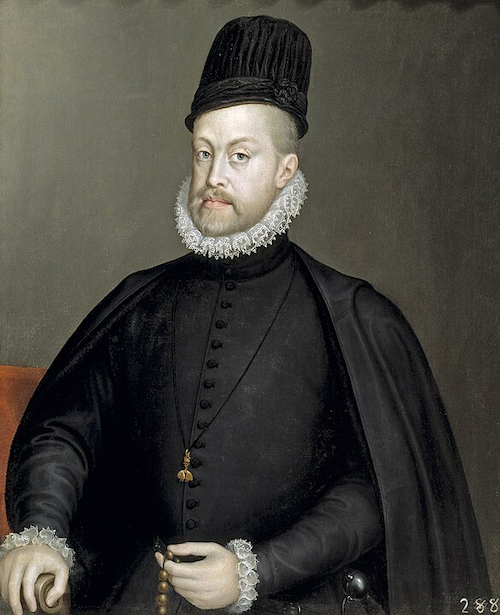Last year, Gonzalo Velasco Berenguer published Habsburg England: Politics and Religion in the Reign of Philip I (1554-1558). The book sheds new light on the reign of Philip I and makes important historiographical moves. Gonzalo tells us more about it here.
What is your book all about?
The book reinterprets the joint reign of Philip and Mary between 1554 and 1558 by focusing mainly on Philip’s figure as king of England. Traditionally portrayed as an unpopular ‘king consort’, in the book I examined Philip’s role as king of England, the universalist aspirations of the Spanish Monarchy, his involvement in government and court, his role in the reconciliation with Rome and Spanish influence in both the theological flavour of the reign and the persecution of heresy.
Your book’s reinterpretation is also a response to current historiography. In light of this, could you tell us what inspired you to reassess Philip I and Mary I’s joint rulership?
In a way, this is something I have been interested in since I first came across their reign as a student at school. When I began my doctoral project, I wanted to understand why such a short reign had received such bad press in the historiography in English. Something which I found particularly odd was a quotation attributed to Philip coming from a letter he wrote to his sister, Juana, then regent of Spain, after Mary’s death in 1558. In the English translation in the Calendar of State Papers, the king told his sister that he ‘felt a reasonable regret for her death’. I went to the Archivo General de Simancas in Spain and tracked the original letter, and that is simply not what he says. So, this quotation, repeated again and again in the historiography and in popular history books to show Philip’s contemptuous feelings for Mary and England was, in fact, a mistranslation. This symbolises a general attitude towards the reign, as much of the historiography has addressed it from a purely Anglocentric point of view which draws its conclusions heavily from John Foxe’s influential Acts and Monuments.
3. In addressing historiography, you also provide a better understanding of Anglo-Spanish relations. Indeed, your book looks at the political and religious domains of both England and Spain. What can we learn about the English-Spanish connection here?
Contrary to traditional interpretations of the reign, England and Spain weren’t caricature-like nemesis destined to be in permanent conflict. In fact, from the 14th century, England and Castile had had close dynastic and trading links. Especially important among these was the triangular wool trade between England, Castile and Flanders. These considerations sealed the marriage between Arthur, Prince of Wales and Catherine of Aragon as well as the latter’s marriage to Henry VIII. Even through the worst years of Anglo-Spanish relations during Henry’s divorce proceedings, the alliance survived, translating into treaties of mutual support in the 1540s which survived until the reign of Elizabeth I and her conflicts with Spain in the 1580s. Philip and Mary’s marriage made perfect sense, not only because it continued this long tradition, but also because it brought dynastic advantages to both monarchies. Politically, if there was some resistance against the Spanish marriage amongst the nobility at the beginning, once the marriage was agreed and Wyatt’s rebellion crushed, it became residual. Philip became an active king of England who made an effort to create a network of loyal noblemen and courtiers and who even introduced a new council, the select council, modelled after the Spanish council of state and which reported directly to him. In terms of religion, England’s population was largely still Catholic or, at least, still attached to old forms of worship, so Philip and Mary’s revitalisation of Catholicism was very successful, given its short lifespan. To this contributed the theological input of Philip’s Spaniards and also the concerted effort to eradicate heresy. To our modern mentalities the latter might not necessarily be a positive outcome, but in the 16th century the persecution of heresy was a tested recipe. According to the testimonies of the king and others, it worked well in both England and Spain.
This Anglo-Spanish connection would have naturally influenced how you went about your research. What fresh archival material did you explore?
One of the most underexplored aspects of the reign is the theological ferment of the religious project built by Philip and Mary. Historians of the reign usually mention the presence of Spanish theologians in England; men such as the Dominicans Bartolomé de Carranza, future archbishop of Toledo and himself persecuted for heresy; Pedro de Soto and Juan de Villagarcía and the Franciscan Alfonso de Castro. However, other than some explorations of Carranza’s figure in the English context by José Ignacio Tellechea Idígoras, John Edwards and William Wizeman, there had been no integration of these men’s theological standpoints and the theology that was being written and published in England. This is especially important given that they were all involved in the revitalisation of Catholicism in England and Soto and Villagarcía were both lecturers at Oxford. I looked at the work of these men in the context of Philip and Mary’s reign, putting them in conversation with their English counterparts.
Another important set of primary materials I used was the inquisitorial records relating to the persecution of Protestants in Spain in Valladolid and Seville between 1557 and 1562, now kept in the Archivo Histórico Nacional in Madrid. The historiography has discussed the Marian persecution in depth, but has virtually ignored the fact that the Inquisition in Spain launched a fierce persecution of pockets of so-called luteranos at the same time as the Marian campaign was taking place. My contention is that this was not a mere coincidence, and that exploring both persecutions in tandem reveals significant details about the aims, methods and outcomes intended by Philip and Mary’s regime.
Thinking about this in the big picture, what would you say is the main contribution of your book?
One of the things I hope to have achieved is to move the conversation away from the Anglocentric approach which has characterised most previous studies of the reign. Almost all historians addressing the subject were answering the question: ‘What did the Spanish marriage mean for England?’ For me, a much more relevant question, given the significance of the Spanish Monarchy in the 16th century, both in Europe and globally, was: ‘What did the English marriage mean for the Spanish Monarchy?’ In other words, why did the marriage come to be, what did the Spanish hope to obtain from it and how did they go about achieving those aims were more important questions.
In exploring those types of questions, what specific aspects of your book corrects historiographical narratives?
There are a few things that I bring attention to in the book which correct previous historiographical interpretations or, at least, question some readings of the episode which have been taken for granted. One of the most important ones, from my point of view, is that Philip was not a ‘king consort’. The figure did not exist, and, even though some strategies were devised to curtail his power, he quickly found his feet and exerted shared power on an equal power with Mary. They had a good working and personal relationship and she deferred many aspects of government to him whilst he was in England. He created his own network of English pensioners and, through the select council, exerted influence in England even when he was abroad. He was a fully functioning king of England, even giving the opening address to parliament in November 1554.
Lastly, could you share any upcoming projects or your current research interests?
Since writing the book, my focus has shifted away from Europe and has turned instead to the global aspects of the Spanish Monarchy. I’m interested in the Monarchy as a whole, but my current research centres in the Philippines. By looking at a variety of primary sources, including church and notarial records, military service accounts, religious texts, nobility claims and others, my current project explores dynamics of family formation and notions of nation and race in the Southeast Asian archipelago in the early modern period.
Gonzalo Velasco Berenguer, Ph.D. (2017, University of Bristol) is a Lecturer in Global Medieval and Early Modern History at the University of Bristol. He is the author of the monograph Habsburg England: Politics and Religion in the Reign of Philip I (1554-1558) (Brill, 2023) and has published articles on early modern England, Spain and Catholicism for the English Historical Review and the Sixteenth Century Journal.

